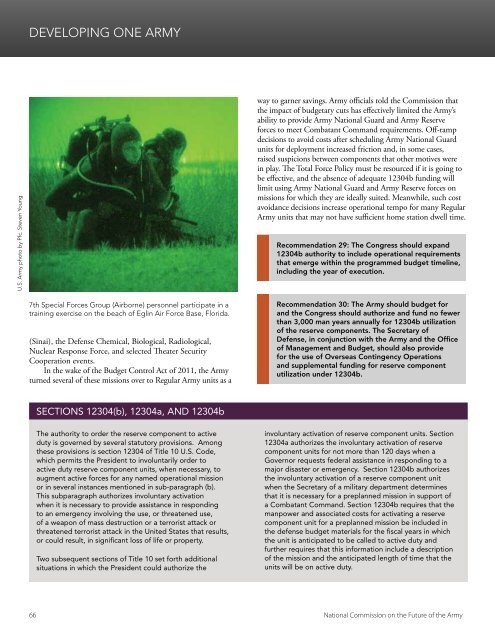THE FUTURE OF THE ARMY
Futurearmy
Futurearmy
Create successful ePaper yourself
Turn your PDF publications into a flip-book with our unique Google optimized e-Paper software.
DEVELOPING ONE <strong>ARMY</strong><br />
U.S. Army photo by Pfc. Steven Young<br />
way to garner savings. Army officials told the Commission that<br />
the impact of budgetary cuts has effectively limited the Army’s<br />
ability to provide Army National Guard and Army Reserve<br />
forces to meet Combatant Command requirements. Off-ramp<br />
decisions to avoid costs after scheduling Army National Guard<br />
units for deployment increased friction and, in some cases,<br />
raised suspicions between components that other motives were<br />
in play. The Total Force Policy must be resourced if it is going to<br />
be effective, and the absence of adequate 12304b funding will<br />
limit using Army National Guard and Army Reserve forces on<br />
missions for which they are ideally suited. Meanwhile, such cost<br />
avoidance decisions increase operational tempo for many Regular<br />
Army units that may not have sufficient home station dwell time.<br />
Recommendation 29: The Congress should expand<br />
12304b authority to include operational requirements<br />
that emerge within the programmed budget timeline,<br />
including the year of execution.<br />
7th Special Forces Group (Airborne) personnel participate in a<br />
training exercise on the beach of Eglin Air Force Base, Florida.<br />
(Sinai), the Defense Chemical, Biological, Radiological,<br />
Nuclear Response Force, and selected Theater Security<br />
Cooperation events.<br />
In the wake of the Budget Control Act of 2011, the Army<br />
turned several of these missions over to Regular Army units as a<br />
Recommendation 30: The Army should budget for<br />
and the Congress should authorize and fund no fewer<br />
than 3,000 man years annually for 12304b utilization<br />
of the reserve components. The Secretary of<br />
Defense, in conjunction with the Army and the Office<br />
of Management and Budget, should also provide<br />
for the use of Overseas Contingency Operations<br />
and supplemental funding for reserve component<br />
utilization under 12304b.<br />
SECTIONS 12304(b), 12304a, AND 12304b<br />
The authority to order the reserve component to active<br />
duty is governed by several statutory provisions. Among<br />
these provisions is section 12304 of Title 10 U.S. Code,<br />
which permits the President to involuntarily order to<br />
active duty reserve component units, when necessary, to<br />
augment active forces for any named operational mission<br />
or in several instances mentioned in sub-paragraph (b).<br />
This subparagraph authorizes involuntary activation<br />
when it is necessary to provide assistance in responding<br />
to an emergency involving the use, or threatened use,<br />
of a weapon of mass destruction or a terrorist attack or<br />
threatened terrorist attack in the United States that results,<br />
or could result, in significant loss of life or property.<br />
Two subsequent sections of Title 10 set forth additional<br />
situations in which the President could authorize the<br />
involuntary activation of reserve component units. Section<br />
12304a authorizes the involuntary activation of reserve<br />
component units for not more than 120 days when a<br />
Governor requests federal assistance in responding to a<br />
major disaster or emergency. Section 12304b authorizes<br />
the involuntary activation of a reserve component unit<br />
when the Secretary of a military department determines<br />
that it is necessary for a preplanned mission in support of<br />
a Combatant Command. Section 12304b requires that the<br />
manpower and associated costs for activating a reserve<br />
component unit for a preplanned mission be included in<br />
the defense budget materials for the fiscal years in which<br />
the unit is anticipated to be called to active duty and<br />
further requires that this information include a description<br />
of the mission and the anticipated length of time that the<br />
units will be on active duty.<br />
66 National Commission on the Future of the Army


